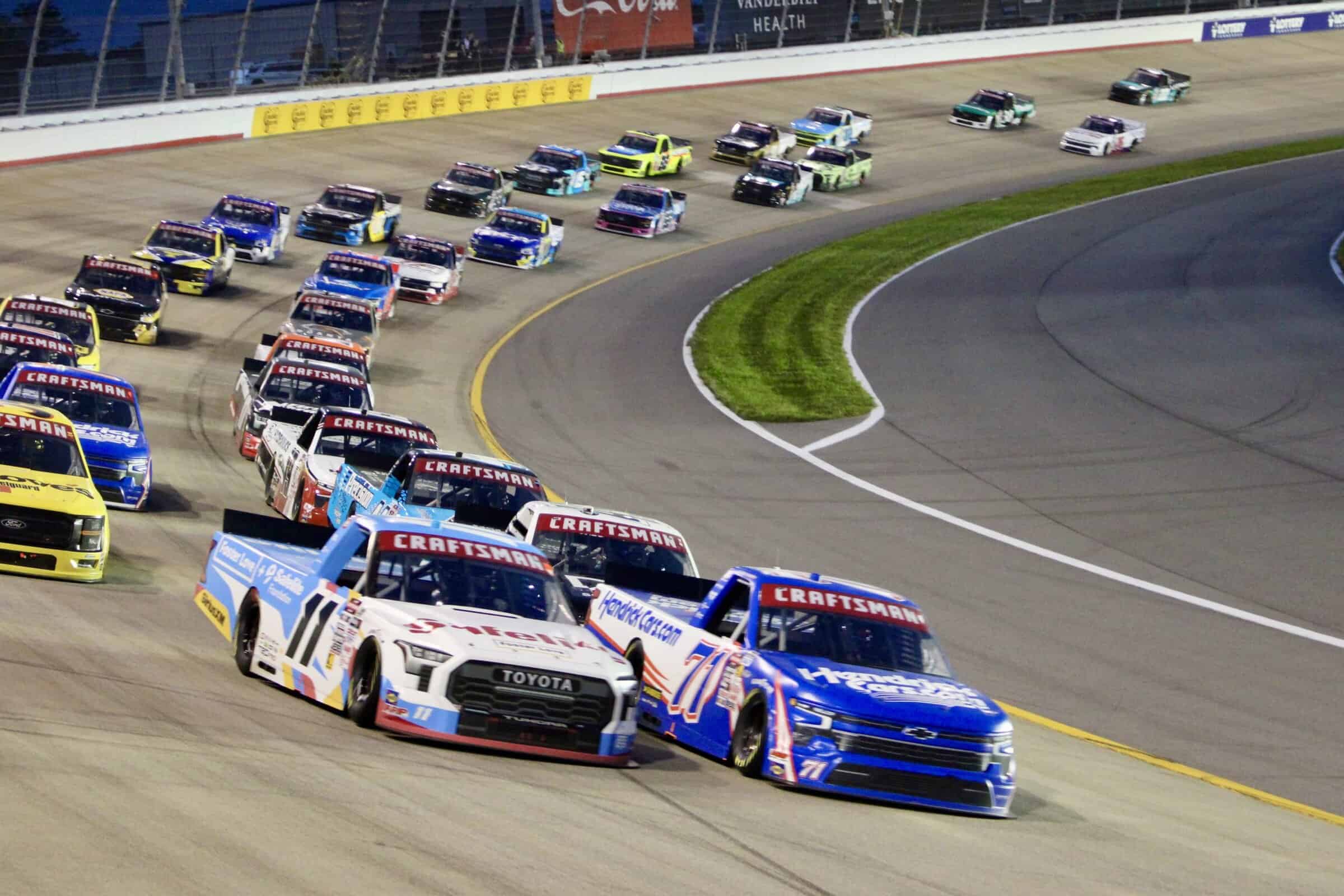A troubling trend of smaller race fields and empty pit stalls for the NASCAR Craftsman Truck Series has emerged during the 2025 season.
In the first 14 races of the year, the Trucks have hosted a full field of 36 teams only once: the season opener at Daytona International Speedway. By comparison, there were six full fields at this point in 2024. In 2023? There were 11.
Where have all the trucks gone?
To find the answer, Frontstretch spoke with five prominent Truck team owners and managers; they asked for and were granted anonymity for this story to speak candidly about the state of their series. Over the course of those conversations, one glaring issue kept coming up: declining financial stability that’s threatening their ability to stay afloat.
“Anyone that has any kind of business sense … can look at a balance sheet and say, ‘This is a nightmare,'” one team official told Frontstretch. “‘This is a complete dumpster fire. Get out, get out, get out.’ … I’m not trying to be dramatic, I don’t know how this Truck Series is going to survive, other than it’s just a rich man’s playground.”
Why that level of panic? Certainly, a slowing economy isn’t helping Truck owners just like everywhere else in NASCAR. But the series is about to get an injection of funding its NASCAR Xfinity and Cup series counterparts will not: Ram is returning as a new manufacturer beginning in 2026. That’s likely to pique sponsor interest while leading to additional money flowing into the series.
But owners maintain that boost just won’t be enough. And their fingers point directly at the one thing NASCAR directly provides the competition after each race: purse money for where they finish.
Truck owners were unified in their disgust over the money NASCAR and the tracks provide for them, complaining at length the totals are a fraction of what their Cup and Xfinity counterparts receive.
“The problem is the purse is so poor through the whole field,” a Truck Series team manager said. “Let’s say you run 30th, you might get $8,000-$9,000, right? By the time you pay for entry fees, one set of tires, mandatory costs, traveling people … you’re already in the hole.
“So, [critics] can all say economy. They can say we spend money ridiculously. I mean, we really don’t. … I don’t want to say I cut corners; I just try and run it practical. But I don’t know how [to survive]. The problem with the revenue is in the prize money. Literally, that is the issue.”
When reached for comment, NASCAR officials pushed back on the notion the Trucks aren’t getting enough.
“Teams want more money in not only the Truck Series but in the Xfinity Series and in the Cup Series,” NASCAR told Frontstretch in response. “That’s nothing new. We do our best to address those concerns and increase the money that goes to the teams. … In the Trucks, they got an increase because of the new media deal that started in 2025.”
Indeed, the $1.1 billion per year from the new TV rights deal upped the purses of each of the top three national series, including the Truck Series. According to NASCAR, it was the biggest increase in prize money in a decade or more. However, Truck Series personnel believe there remains a significant discrepancy between what they were given compared to their Xfinity counterparts.
For example, according to one source, the Xfinity Series rewarded a bonus of $4,000 to the finishers of 31st-35th place at February’s season-opening event at Daytona. That adds up to a $20,000 increase to the overall purse.
For the Truck Series that the same weekend, the prize money bonuses ended at 25th position, with $1,000 being awarded to the finishers of 21st-25th. The rest of the field, an extra 11 teams, didn’t receive any bonus reward for their finishes. While still an increase, it is $15,000 less than the Xfinity example above. And unlike the NXS field, there were 11 teams that did not receive a bonus whatsoever.
It leads to a feeling, especially among smaller Truck Series owners, that they’re not being well taken care of compared to everyone else. However, NASCAR said the difference boils down to different contracts: While the Truck Series remained with FOX, Xfinity signed a separate media deal with a new partner in The CW.
“It’s two different discussions of two different media rights deals,” NASCAR said. “It’s a little bit of a different model too, because NASCAR produces races, so a certain amount of money goes to the production of that, so CW is not producing those races. Those are coming out of a NASCAR Production facility.
“… You’re also talking about two different figures. A percentage of the larger figure is giving more money.”
Naturally, as NASCAR’s second-tiered division, the Xfinity Series is supposed to reward more when it comes to purses compared to the Trucks. However, according to team owners and managers, that doesn’t mean the Truck teams spend less. In fact, many of the costs remain the same.
“I understand [Xfinity] have maybe more directors,” a Truck Series manager said of his costs compared to NXS. “They have maybe more engineers … labor’s a huge cost, largest cost in a company.
“But the truck going down the highway still has the same insurance that ours does, the same fuel cost, same taxes, same liabilities about your exposure, same truck driver cost, pit equipment, same. Their tire bills are more. Their engine bills are more. But if you look at it across the board — workforce, buildings, general liability insurance, what you got to produce — the ratio is so far off on what we make in prize money compared to what they make.”
In some cases, owners maintain the costs can even exceed the Cup Series.
“With the [Next Gen] car, it dropped payroll,” this Truck team manager continued. “It dropped the level of skillset it takes. I have guys out here that weld chassis together. I don’t know a Cup shop right now that does that. No one does.
“So, what you have to pay someone is higher for us than it is for them. I’d be willing to bet I have more trucks here than … close to what they have for Cup cars because of how universal it is for them to run the cars at multiple events. … I think I’ve heard Cup teams brag about, ‘Hey, we just took this car that ran at [Circuit of the Americas], and we brought it to Nashville [Superspeedway].
“We couldn’t even think about doing that, so that model’s broken.”
NASCAR, when it can, feels strongly it has made attempts in recent years to help the teams save money through certain cost-cutting measures. They hope the conversation with Truck ownership continues on how the series can be more efficient.
“We’ll see where we can help them in certain ways,” NASCAR told Frontstretch. “We have worked over the years to evolve the competitive model of the Truck Series so that it’s profitable and affordable. Whether that’s helping increase the purse. Whether that’s Ilmor engines. Whether that’s some of the engine rules, back-up truck rules. Crew member uniforms. … Rosters. If you look over the course of several years , since we’ve had rosters [limiting at-track personnel], that has probably saved the teams millions.”
However, there are a number of Truck Series back marker entries that still struggle to make it to the racetrack, and that, combined with inflation and rising costs of an increasingly brutal travel schedule, has resulted in teams leaving the series.
“It costs $10,000 to go to Las Vegas [Motor Speedway] and back,” a team owner said in late February. “So, if we have 32 Trucks going to [EchoPark Speedway], how many trucks do you think are going to go to Vegas? Probably not 30-freaking-2.”
Indeed, this year’s Las Vegas Truck race had a field of 31 — the smallest amount in a race since Canadian Tire Motorsports Park in 2019. Two months later, it bottomed out at 31 again with a short field at Kansas Speedway.
Compare that to the Xfinity Series, which has had a full 38-car grid for 25 straight races, and it’s easy to see which division is less healthy.
“Xfinity, do they have more expenses? Sure,” one team owner said. “But we don’t need to talk about it … You have Xfinity teams going home, and you have short fields in Trucks.”
NASCAR stated it does have a collaboration committee in place that is attended by series directors and eight series team owners from ThorSport Racing, Spire Motorsports, McAnally-Hilgemann Racing, Niece Motorsports, Front Row Motorsports, Reaume Brothers Racing, Halmar Friesen Racing and TRICON Garage.
However, according to some, their voices don’t feel heard in lieu of the more prominent ones from team owners in higher series.
“The meetings in Cup happen at an ownership level,” a Truck team owner further explained. “[NASCAR] has them with Rick Hendrick. They have them with Roger Penske. … They have literally a stake in the business [with charters]. Truck and Xfinity teams, when we have meetings [with NASCAR], they are happening with competition directors and general managers. That is totally wrong.
“… [NASCAR] want their jobs to be easier. They do not invite change. … They want it done one way. Whenever there’s any conversation to reinvent the wheel on anything to try and save money or get creative, they’re the first ones to shut it down.”
So what do the owners think the solution can be? How can the Truck Series start seeing full fields again?
“NASCAR needs to find a way to share that love,” a different Truck Series manager said. “I swear the numbers I saw [were] like $11 million for the Pocono [Raceway] prize money on the Cup side. Ours was like $780,000, maybe, give or take? It’s grossly unbalanced. I mean, I don’t see how all the money goes to Cup.”
The problems hit at a time when the Truck Series has put together one of its more competitive years in recent memory. There have been seven different full-time drivers reach victory lane in the first 14 races, leaving hope a full field of 10 individual Truck winners will reach the postseason for the first time in its history.
“The racing’s so damn good,” a Truck team leader said. “It really is. … It’s a good quality race, and we’re spending good quality money to put this show on.
“But I don’t think we fairly get any nice piece of the pie at all. So what’s got to change? It’s just NASCAR’s got to increase the prize money.”
This weekend, the Truck Series will experience its inaugural visit to Lime Rock Park, expanding into another new market. It’s something NASCAR has done plenty of in the last few years.
However, even with a padded entry list including road course ringers and one-off starts, the field will still only amount to 35 Trucks that will take the green flag.
Once again in 2025, a full field will elude the series.
Dalton Hopkins began writing for Frontstretch in April 2021. Currently, he is the lead writer for the weekly Thinkin' Out Loud column, co-host of the Frontstretch Happy Hour podcast, and one of our lead reporters. Beforehand, he wrote for IMSA shortly after graduating from Embry-Riddle Aeronautical University in 2019. Simultaneously, he also serves as a Captain in the US Army.
Follow Dalton on Twitter @PitLaneCPT





